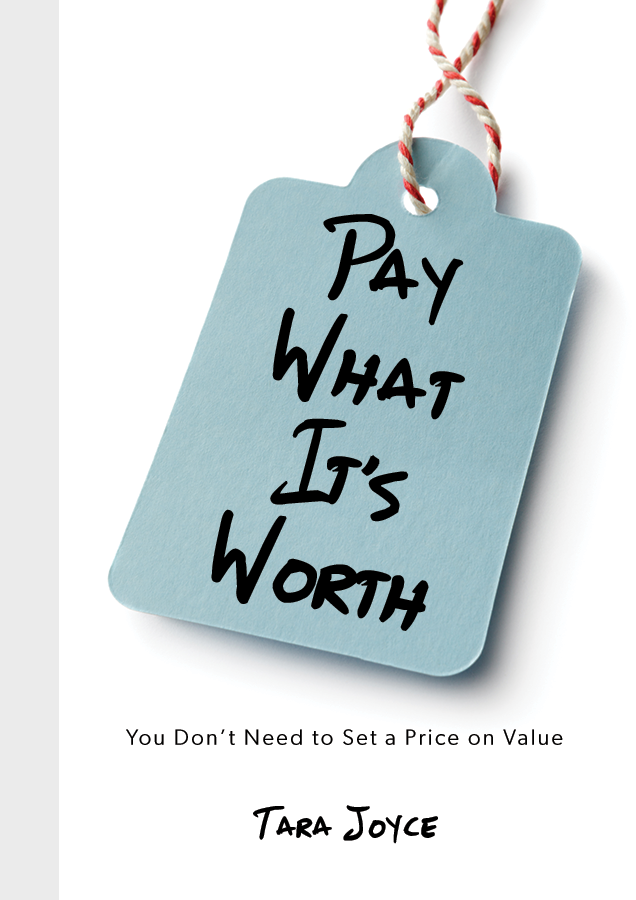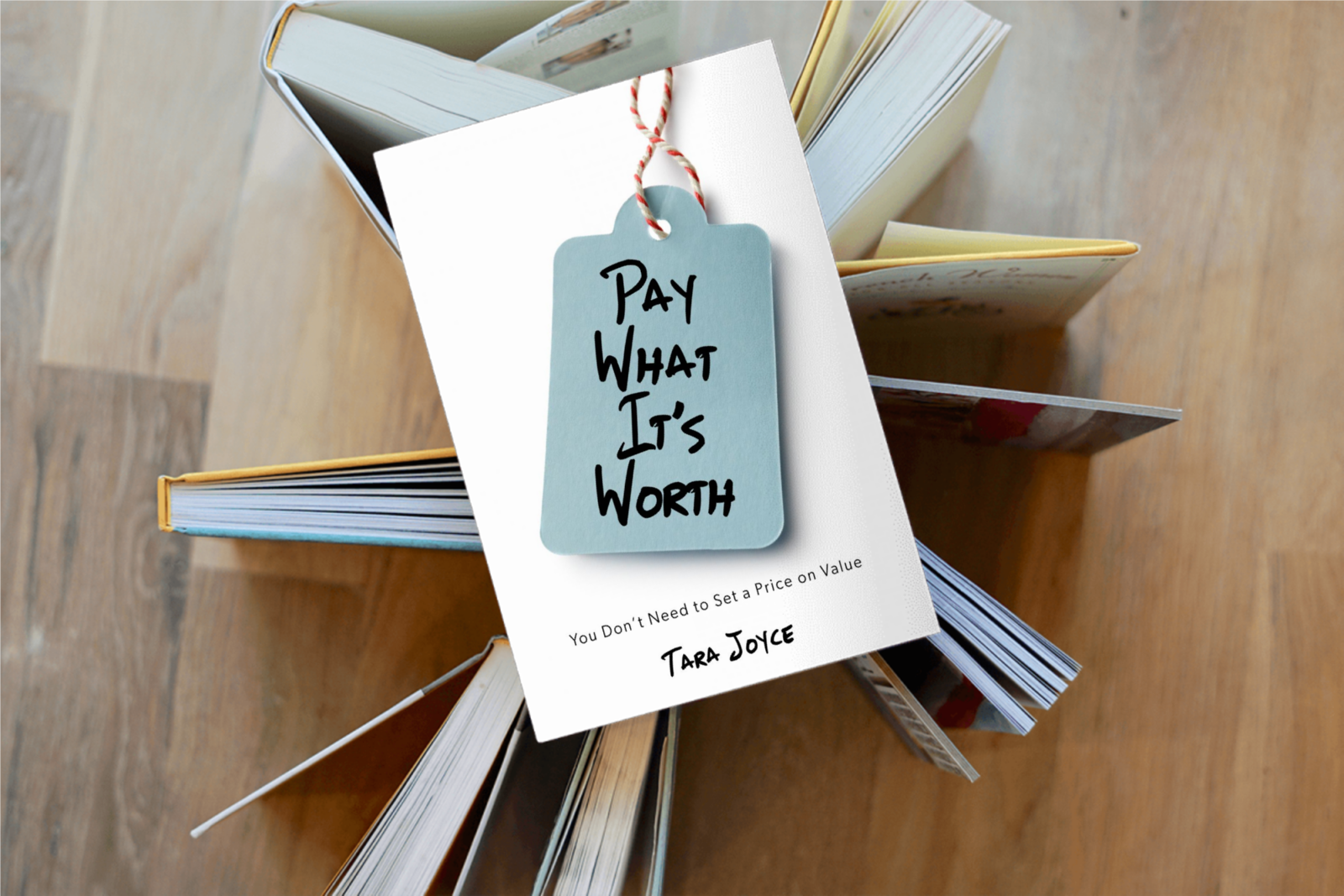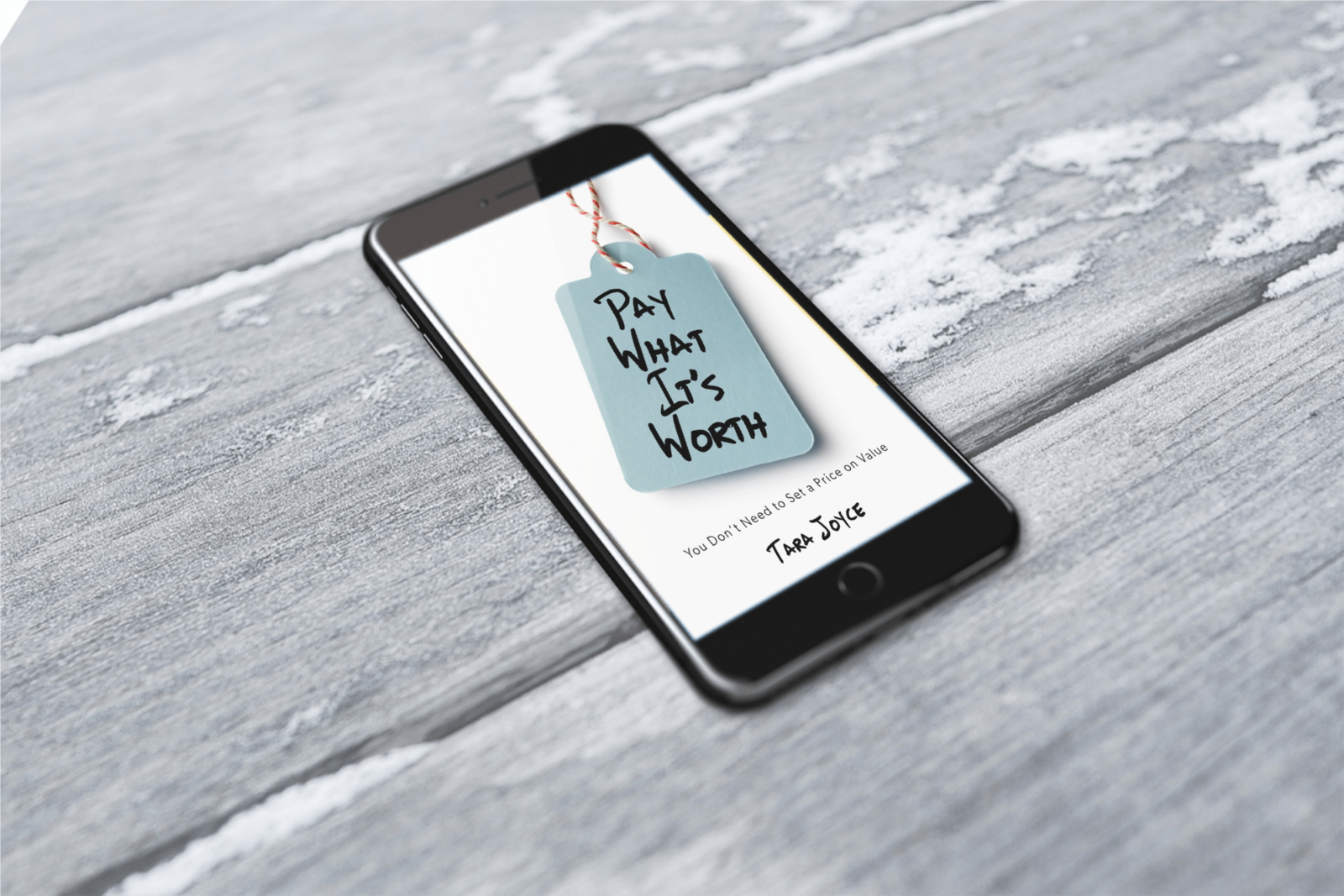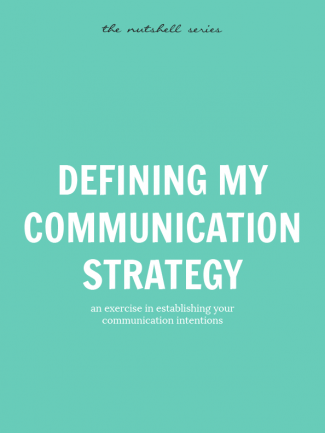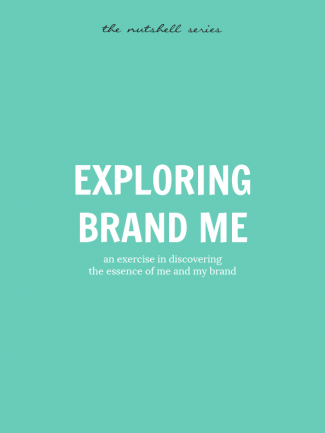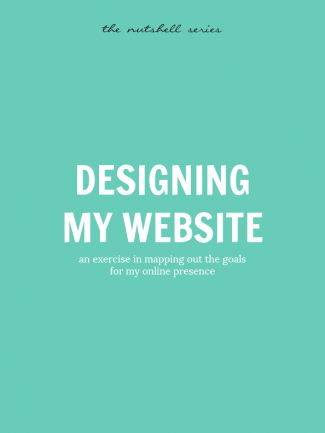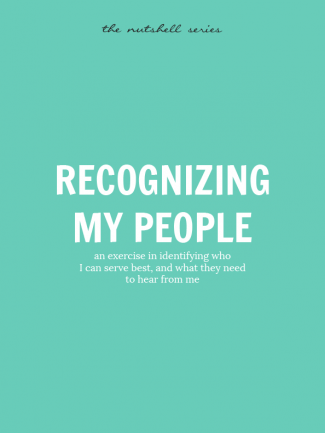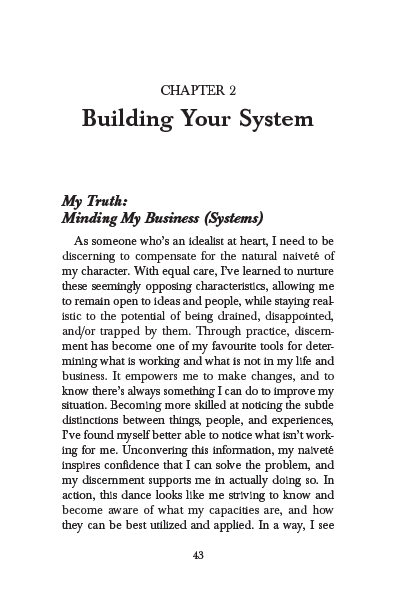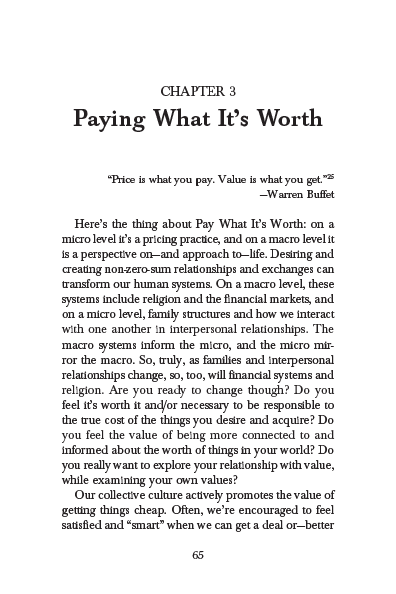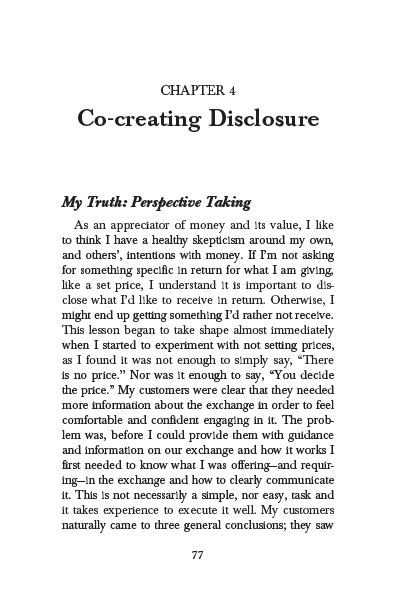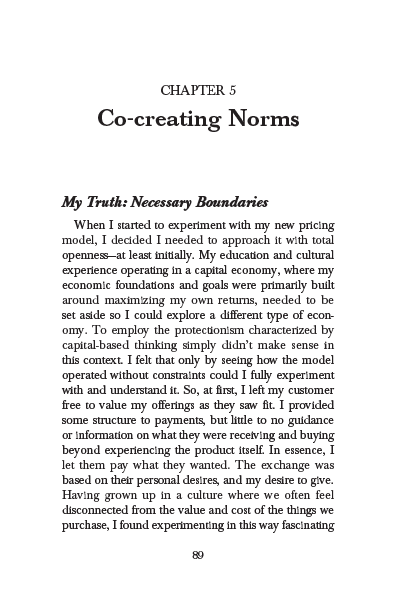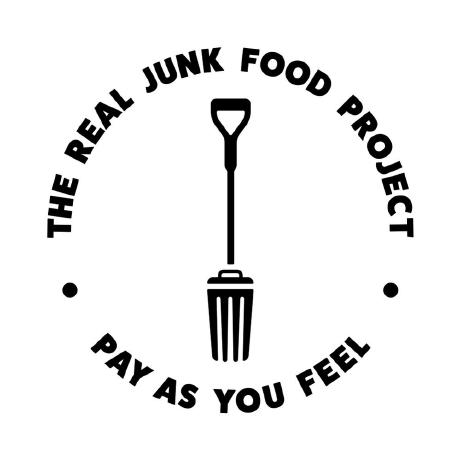Pay What It’s Worth: You Don’t Need to Set a Price on Value
By Tara Joyce
Business & Economics | General
In Pay What It’s Worth, Tara Joyce provides an elegant framework for understanding how not setting prices can be a viable strategy for your small business. Consciously explore your relationship to money, to other people, and to exchanging value. Imagine, the growth made possible when you don’t set a limit to your business’ value.
Iguana Books
Paperback & eBook Format
Pay What It's Worth EXPLAINED
This product was lovingly crafted by me, Tara Joyce, and is for sale to you at the price you feel it is worth.
Please carefully consider the value you place on the creation and give accordingly.
When considering the value you place on the product, you could consider:
- your (perceived) level of satisfaction with the product, and the level of satisfaction I may feel in your valuation.
- your abilities (financially and otherwise) to contribute to the exchange and the abilities (financially and otherwise) I have contributed.
- your market awareness of the product and what you may receive from it and what has been put into it.
- your sense of fairness in the exchange
What if the customer determined the price they pay, rather than the business, based upon the value they receive? How might that change things? Pay What It's Worth pricing is a system allowing for a different way of valuing the products, services, and experiences we have and exchange with others. Each of us has the power and ability to create our own economy, and approach to valuing products and services.
In Pay What It's Worth: You Don't Need to Set a Price on Value, you'll explore the power and potential, as well as the pitfalls, of not setting prices. Mutually beneficial exchanges are possible and sustainable for you, as a business owner, and as a customer. Your integrity is your most valuable wealth creation tool.
Additional information
| Weight | .21 kg |
|---|---|
| Dimensions | 24 × 18 × 2 cm |
| Format | Paperback, eBook |
Chapter 1: The Foundations
My Truth: Exploring the Heart of Value
It would be convenient to think my own journey with Pay What It’s Worth began when I was shaping my business—but the reality is, I started on this adventure far earlier. My education, experiences, and environment were all integral to my decision to take this journey. They formed the foundation of my relationship with money, and my recognition of it as a tool for empowerment.
Business was a fundamental part of my life growing up. My father is a real estate entrepreneur and very much a traditional businessman who thinks of profit first. For him, a day is worthwhile and joyful when he makes money. As a kid, I discovered business was a powerful tool to connect with him, and to build our relationship. We would spend time together talking about his business and the business world at large. I found satisfaction and love in connecting with him this way, and in supporting him however I could, that, as odd as it may sound, business became one of my favourite tools for exchanging love. This early belief stayed with me. No matter what the rest of the world thought and taught, I knew the truth. Business is about relationships—it is about exchanging value and it is about service. It is in my nature to be loving and generous, and business became a natural tool for me to express this.
At a very early age, I also had my first lessons in understanding my external value, and my first experiences of providing a service and of being fairly paid for it. At the age of two, I was employed as a model and I received my first paycheque. I continued to work steadily as a child and to learn about the intrinsic value of doing my best work, and the external value of being paid for it. Later, when I was fresh out of undergraduate business school, I participated in my first Pay What It’s Worth experience, though only years later did I realize that was what it was. I was a marketing associate, and one of my roles was doing the accounting administration for our department. Each month I would process the blank invoices of our graphic designer. My manager would determine the price on the invoice and how much our designer would receive for the project(s) he’d worked on. Their relationship’s foundations were shaped by trust—he trusted her to fairly value his work, and she trusted him to skillfully and consistently deliver work she valued. There was an ease and fluidity to their relationship that unknowingly stayed with me. When I shaped my own design business this experience helped me feel confident that nurturing my relationships would continue to bring wealth into my world.
Does this truly answer why I came to question setting prices and why I was willing to risk my business health (and my personal wealth) to explore an alternative? I’d say, no, not really. The truth is there was something deeper, more unconscious, driving my decision… I was in pain, and I was looking to relieve it and heal myself, using business as a tool. Extremely sensitive to money being misused, especially to gain power over another, I was hurt by and rebelling against the scarcity mindset and fear-based messaging I saw all around me. I objectively live in abundance, and yet I had learned to believe in—and invest in—scarcity. As my colleague Ebele Mogo wrote, “a language and logic of fear and scarcity around money and finances” (personal communication, July 13, 2014) pervaded my world. With my newly forming business relationships, I could choose differently—and create things differently. Not setting prices was my way of critiquing my experience in a scarcity-focused economy, by creating a different relationship with money and with exchanging it than I had known previously. It was my money pain that led me to question my scarcity mindset and to feel I could trust people (and myself) to be fair in their giving. I needed to believe there was a different perspective on money, and of others, that I could grow wealthy with.

Overview & Preview
7 Chapters
146 Pages
What if the customer determined the price they pay, rather than the business, based upon the value they receive? How might that change things? Pay What It’s Worth pricing is a system allowing for a different way of valuing the products, services and experiences we have and exchange with others. Each of us has the power and ability to create our own economy, and approach to valuing products and services.
In Pay What It’s Worth, you’ll explore the power and potential, as well as the pitfalls, of not setting prices. Mutually beneficial exchanges are possible and sustainable for you, as a business owner, and as a customer. Your integrity is your most valuable wealth creation tool.

Sample Pages
Table of Contents
Valuable Words
Why Pay What It's Worth?
UNDERSTANDING
Chapter 1 — The Foundations
My Truth: Exploring the Heart of Value
Understanding the Current of Exchange
Exploring Our Money Shadow
Rethinking Money
The Importance of Integrity
Chapter 2 — Building Your System
My Truth: Minding My Business (Systems)
Your Constraint to Not Setting Prices
Building a System that Lasts
Perceptions of Value
Your Economic Opportunity to Co-create
THE SPACE BETWEEN
Chapter 3 — Paying What It's Worth
ACTION
Chapter 4 — Co-creating Disclosure
My Truth: Perspective Taking
What Disclosure Looks Like
The Open Sharing of Relevant Information
Disclosing A Price
Communicating Value
Chapter 5 — Co-creating Norms
My Truth: Necessary Boundaries
What Norms Look Like
Clear and Well-Founded Rules
Building Strong Connections
Chapter 6 — Co-creating Accountability
My Truth: Exploring My Role
What Accountability Looks Like
The Establishment of Fair Consequences
Ending Relationships
Taking Responsibility
Chapter 7 — It's Your Combination
My Truth: Giving = Receiving
Understand Your Generosity
Transform to Thrive
Resources
Acknowledgements
Footnotes
Get Your Chapter Excerpt
“Why Pay What It’s Worth?”
Sign up and receive the chapter excerpt,
Why Pay What It’s Worth?
Why Pay What It’s Worth?
Benefits to Businesses & Entrepreneurs
- Your customer relationships grow and strengthen in new, unique ways.
- Your business’ value and principles become central to your brand’s identity.
- Your pricing systems inherently become more tailored and effective.
Benefits to Artisans & Innovators
- Your audience will better communicate how they price and value your work.
- Your art/innovation and its value is given the ability to grow as you do.
- Money and how it’s exchanged becomes a tool for shared social responsibility.
What is Pay What It’s Worth pricing?
Who is Pay What It’s Worth pricing for?


FUTURIST Author
Tara Joyce
Unfulfilled at 26, Tara Joyce left her corporate marketing career to start her own business and to explore how she wanted to be of service. Quickly, she was attracted to the seemingly backwards strategy of not setting a price and to allowing her customers to determine the value of her offering, and to sharing what she learned through her blog, Rise of the Innerpreneur. Today, the “Pay What It’s Worth” concept and Tara’s published work support people globally in exploring their own scarcity and fear-based ideas around money, value, and business relationships. Tara lives in Peterborough, Canada with her husband, daughter, and canine son.
Practioners
These businesses all practice with not setting prices. Each of them has an unique approach to creating a fair and strong pricing system where their customer determines what they pay.
Click on each to explore their “Pay What It’s Worth” approach.
There are far more businesses than these practicing with paying what it’s worth. If you know of any to add to this list, please let me know.
Tools
Tools for Exploring Pay What It’s Worth Pricing
Is Pay What It’s Worth Pricing For Me?
an exploratory checklist
A tool to support you in determining if PWIW is right for your business.
Tools for Building a Pay What It’s Worth eCommerce Presence
wordpress
epublishing tool, available for free
A tool to create your business website.
woocommerce
wordpress Ecommerce tool, available for free
A plugin tool to create an eCommerce store, running on the WordPress epublishing tool (mentioned above).
woocommerce name your price
woocommerce add-on, available for $
A plugin tool to allow customers to set their own price for products and donations, works in tandem with Woocommerce & WordPress.
I use this add-on and varktech minimum purchase (below) to run my online store.
varktech minimum purchase for woocommerce
woocommerce add-on, available for free
A plugin tool that allows the seller to have minimum purchase functionality (aka, not offer their items for free), works in tandem with Woocommerce & WordPress.
I use this add-on and woocommerce name your price (above) to run my online store.
Tools for Providing Pay What It’s Worth Services
My shared agreement (for providing service)
an agreement my customer and i sign
An example of creating structured communications to support your PWIW system.
Meet Tara
AUGUST 11, 2021 (Past Event)
Pay What It's Worth, Beyond the Book • Online
Hosted by Laurier Alumni (I attended Wilfrid Laurier University from 2000-2004).
Join author Tara Joyce (BBA ’04) and Globe and Mail Changemaker Award winner Sara Bingham, associate director of Laurier’s Women Entrepreneurship Centre for a fireside chat as we take the conversation on Pay What It’s Worth Beyond the Book to discuss entrepreneurship, the understanding of business, money and value; setting prices or not!

